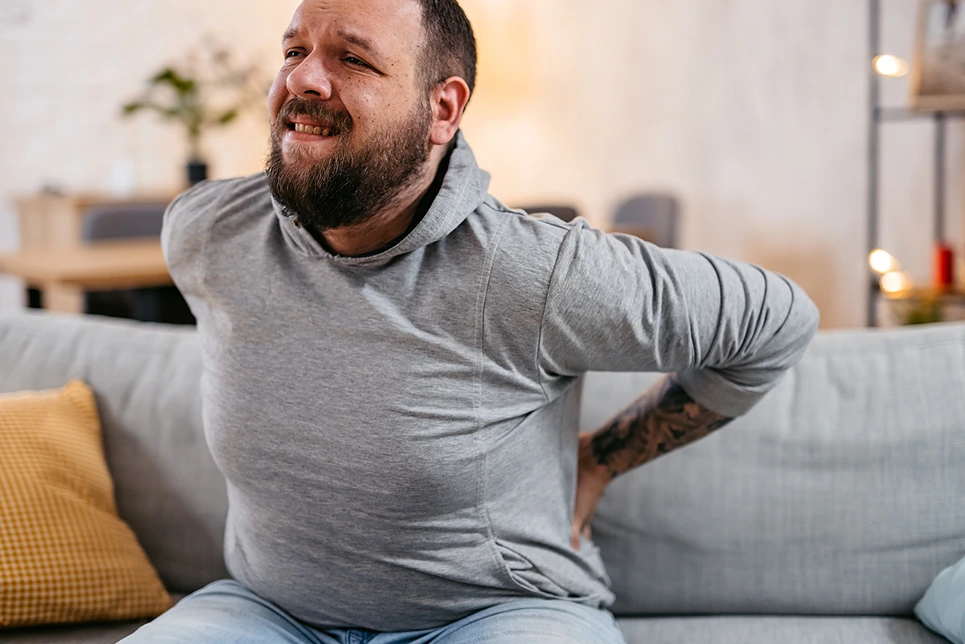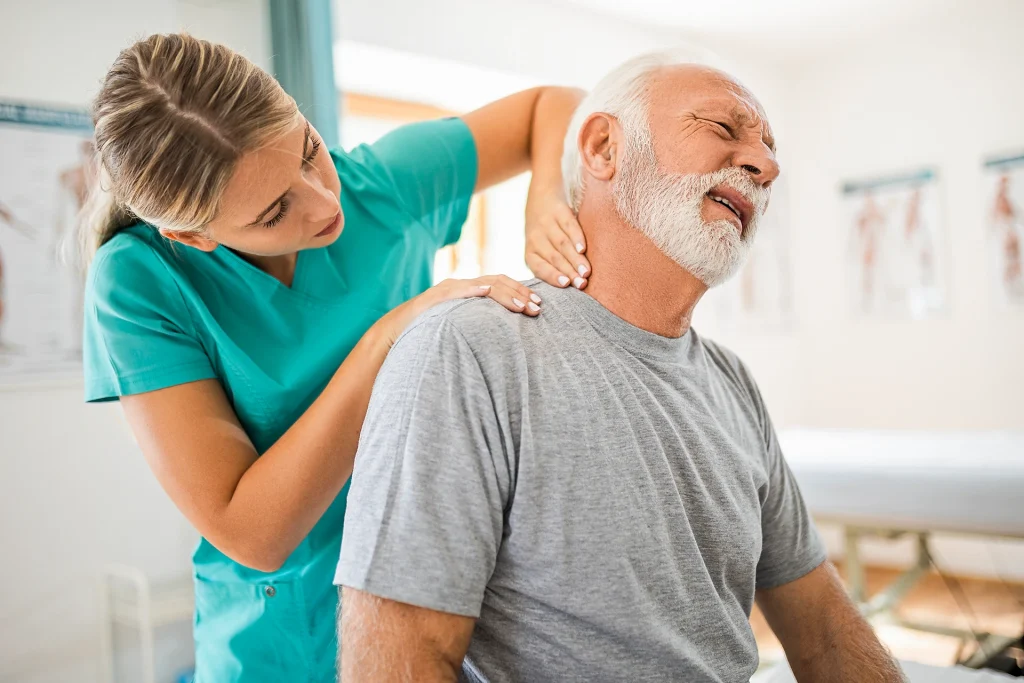Science-Based Insights and Self-Care Strategies
Back pain and body aches have become one of the most commonly reported symptoms of the highly transmissible omicron variant.
As omicron cases surge around the world, many who contract the virus are left wondering why they are experiencing persistent back pain and how to find relief.
In this blog post, we’ll explore the connections between omicron and back pain complaints, arming you with science-based insights and practical self-care tips.
First, let’s examine what experts know so far about omicron’s array of symptoms and its tendency to provoke back pain in particular.
What Are the Common Symptoms of Omicron, and Is Back Pain One of Them?
Since omicron emerged, researchers have been racing to define its constellation of symptoms.
Many infected with this latest coronavirus variant are reporting cold and flu-like sensations like runny nose, headaches, fatigue and body aches. However, unlike earlier variants, a loss of taste and smell appears to be less common.
Omicron does seem adept at instigating muscle aches and pain, especially in the back. One major study from Norway found that 60% of omicron patients experienced back pain, describing the discomfort as moderate to very severe. Lower back pain is especially common.
This back pain prevalence is significantly higher than seen with delta variant infections, which caused back pain in just 19% of patients. Experts theorize omicron’s particular mutations could enhance its ability to provoke painful inflammation and soreness throughout the body.
So in short—yes, back pain is a hallmark sign of an omicron infection for many affected. Lower back discomfort, sometimes extending into the tailbone region, appears to be the variant’s preferred location to attack.
What Causes Back Pain Related to Omicron?
There are several physiological explanations for why omicron is associated with back pain symptoms:
Inflammation: Omicron triggers a strong immune response that floods the body with inflammation-producing cytokines. This can irritate nerves and heighten pain perception.
Body aches: Like other viruses, omicron can cause generalized muscle and joint aches as part of the immune response. These aches can concentrate in the back.
Muscle pain: Back muscles may be directly impacted, becoming tender and spasm-prone. Prolonged coughing can also strain back muscles.
While back pain can be expected with any viral illness, omicron appears particularly adept at locking its sights on the back.
Researchers found this preference for lower back pain perplexing, as other COVID variants like delta did not home in on the back to the same degree.
However, it does reinforce the importance of keeping an eye out for spinal symptoms when assessing your health during the omicron wave. Back pain, especially when severe or persisting beyond a few days, warrants checking in with a doctor about testing and proper treatment.
Distinguishing Omicron Back Pain from Other Conditions
Onset
Omicron back pain starts abruptly within 1-3 days of other viral symptoms. Chronic or injury-related pain generally develops gradually over time.
Location
Omicron pain is more localized to the lower back area rather than widespread joint pain with arthritis. Injuries usually cause localized pain in one small area.
Severity
Omicron back pain ranges from moderate to severe, while arthritis and injury pain is often milder at rest. Omicron pain also fluctuates more throughout the day.
Aggravating factors
Coughing and deep breathing tends to worsen omicron pain more than other sources due to chest congestion. Changes in weather or overuse worsen arthritis.
Duration
Omicron back pain is temporary and resolves within weeks as the virus clears. Arthritis and injury pain is more persistent unless treated.
Context
Presence of other viral symptoms like fever, fatigue and congestion points to omicron as the likely cause of new-onset back pain.
If you are experiencing new, unexplained back pain with features like these, there’s a good chance omicron could be the source, especially if other flu-like symptoms are present. However, always discuss with a doctor to rule out other possible causes like a muscle strain, kidney stone or spinal condition.
Reporting your full range of symptoms will help healthcare providers determine if COVID-19 testing is warranted.
Coping Strategies for Finding Omicron Back Pain Relief

Managing omicron back pain flare-ups involves tapping into coping strategies that can temporarily provide relief:
- Relaxation techniques – Try meditation, deep breathing, progressive muscle relaxation to reduce anxiety and muscle tension.
- Gentle movements – Carefully stretch, do light yoga, pelvic tilts or knee rolls to ease stiffness. Avoid sudden twisting.
- Posture modification – Adjust seated and standing positions to reduce strain on tender areas. Use lumbar support.
- Cold/heat therapy – Apply ice packs or heating pads to help ease muscular back pain when possible.
- Massage – Use hands or tools like foam rollers or tennis balls to gently knead and release tight muscles.
- Pain management medications – Utilize OTC options like acetaminophen, ibuprofen or topicals as recommended by your provider.
- Activity pacing – Take regular rest breaks between tasks to avoid overexertion. Prioritize essential activities only.
- Distraction – Direct your attention to enjoying music, reading or other hobbies you can do while resting.
Persisting with these coping mechanisms can provide cumulative pain relief as your body recovers. But always seek medical guidance for any concerning or worsening symptoms.
Long-Term Outlook and Recovery from Omicron Back Pain
The vast majority of those afflicted with omicron back pain start feeling better within 1-2 weeks as the virus clears.
However, a small percentage experience longer lasting back discomfort categorized as post-viral or “long omicron” pain. This extended pain tends to fade gradually over the following 1-3 months.
| Recovery Phase | Timeline | Description |
| Acute back pain | 1-2 weeks after infection | Most severe back pain occurs as virus peaks and begins clearing |
| Early recovery | 2-4 weeks after infection | Back pain improving as virus clears; some lingering discomfort common |
| Post-viral back pain | 1-3 months after infection | Gradual fading of stubborn minor pain; small % have longer-lasting pain |
| Full recovery | Varies; typically within 3-6 months | Complete resolution of omicron back pain and return to normal activities |
Some tips for supporting full recovery:
- Avoid re-injuring your back before it has fully healed. Ease back into regular activity. Use proper lifting mechanics.
- Address any residual muscle tightness or imbalance with stretches, gentle strengthening exercises and activities like yoga or swimming.
- If pain persists beyond 3 months, pursue physical therapy for customized treatment to resolve lingering back issues and prevent future problems.
- Make ergonomic adjustments to your workspace, sleep area, and home to reduce strain on your spine during daily activities.
- Manage stress levels, maintain a healthy diet and body weight, and boost general fitness to take pressure off your back.
While omicron back pain can linger as our bodies mend, being proactive with self-care can help prevent lasting dysfunction or disability.
Seeking Relief for Omicron Back Pain

When omicron back pain has you feeling desperate for answers and relief, it can be challenging to know where to turn.
But platforms like Kaly simplify finding providers equipped to address your specific symptoms.
Their intelligent matching connects you with local doctors based on expertise, availability, reviews and your unique needs. This takes the guesswork and stress out of getting the right back pain care.
With just a few clicks, you can book appointments with trusted providers ready to ease your omicron troubles and get you back on the road to recovery.
